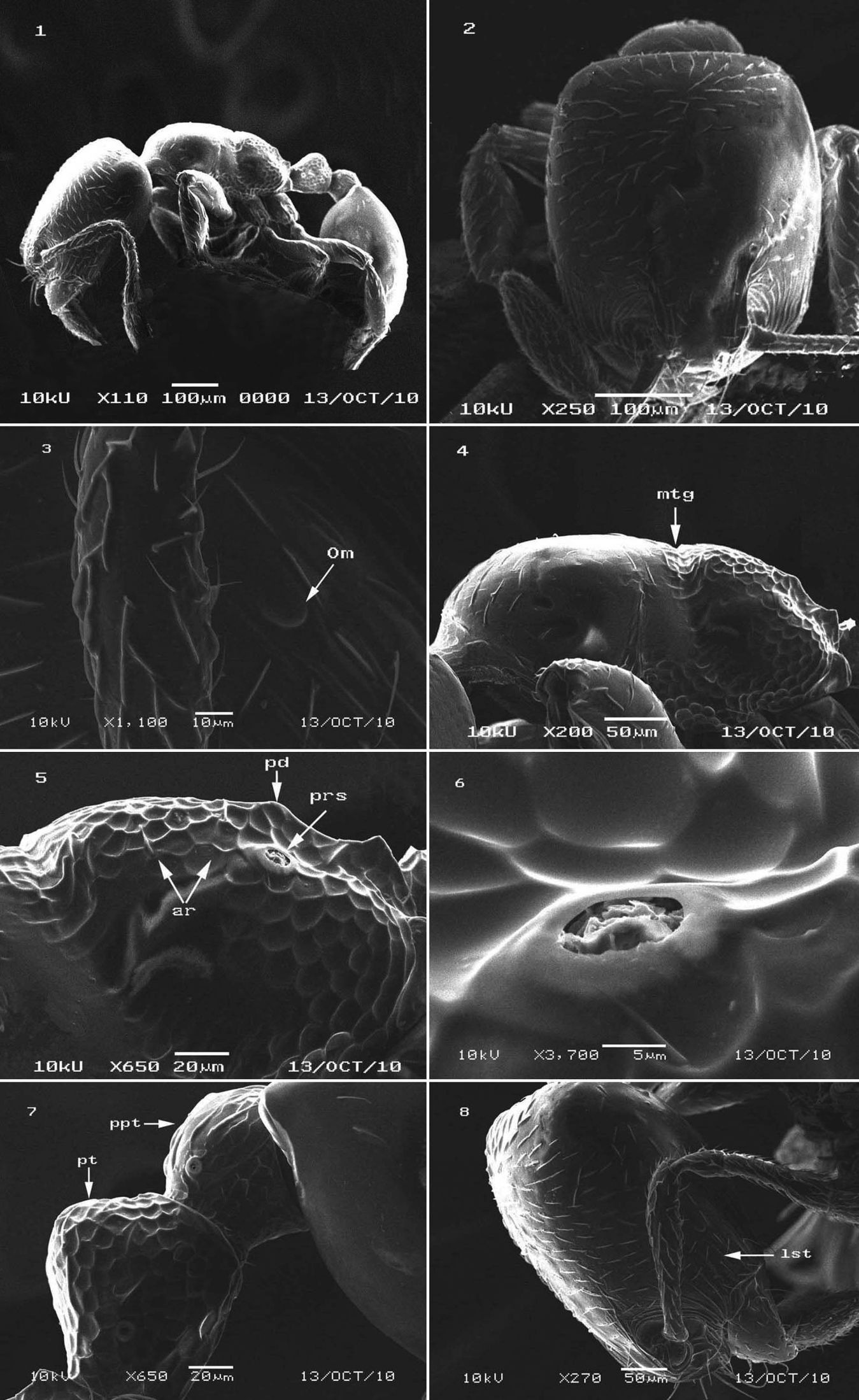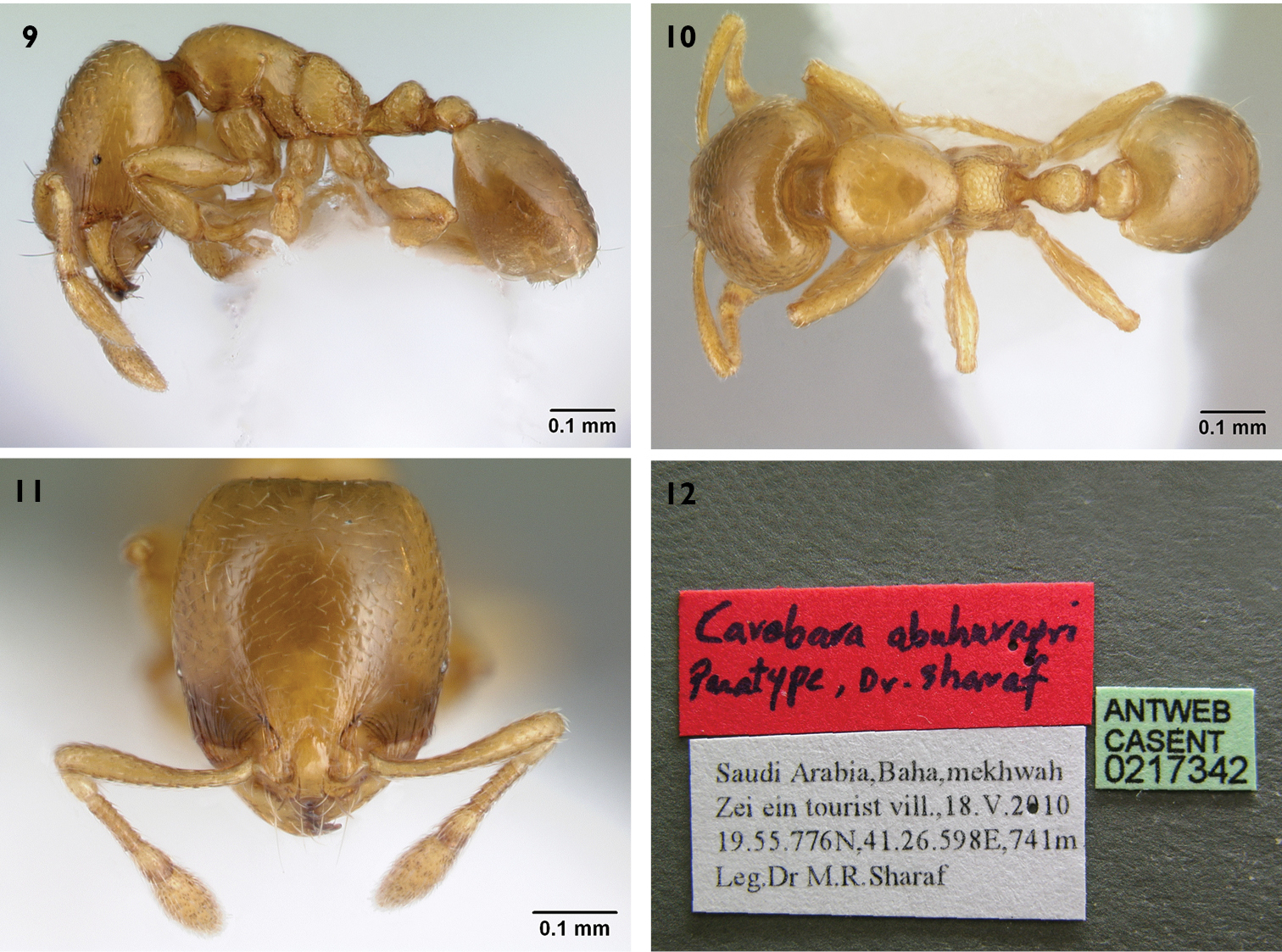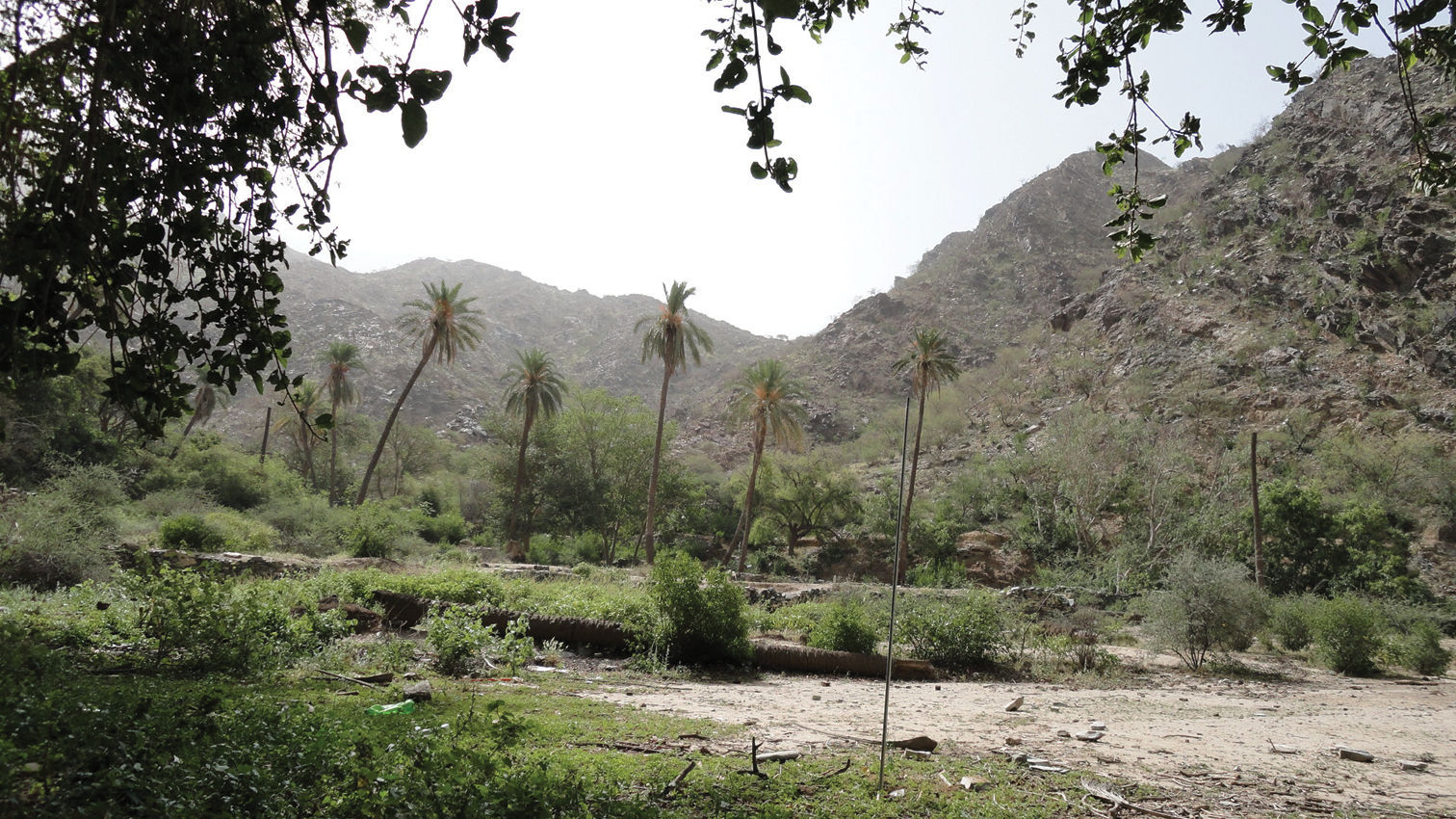(C) 2010 Abdulrahman S. Aldawood. This is an open access article distributed under the terms of the Creative Commons Attribution License, which permits unrestricted use, distribution, and reproduction in any medium, provided the original author and source are credited.
For reference, use of the paginated PDF or printed version of this article is recommended.
The myrmicine ant genus Carebara is recorded for the first time in Saudi Arabia from the Arabian Peninsula as a whole. A new species Carebara abuhurayri sp. n. is described based on workers collected from Al Bahah region. One of the smallest ant species known to occur in Arabia, Carebara abuhurayri is found in an area inhabited by many ant species including Tetramorium sericeiventre Emery, 1877, Pheidole minuscula Bernard, 1952, Pheidole sp., Monomorium destructor (Jerdon, 1851), Monomorium exiguum (Forel, 1894) and Monomorium sp. and Crematogaster sp.
Ant fauna, Palaearctic, Asir province, Al Bahah, Arabia, new species, Myrmicinae, taxonomy
The ant genus Carebara Westwood, 1840, sensu
The taxonomic knowledge also is limited.
There are anomalies, however, in the Fernández proposal which was based primarily on the American fauna. In particular, it does not gel with the contrasting dimorphism of the Oligomyrmex workers, with minors, ca. 1.0 mm in total length (TL), and majors, TL ca. 2.0–2.5 mm, coupled, where known, with queens of a similar general morphology to the major workers and no more than twice as long, TL ca. 5–6 mm or less and the Carebara s.s. which have monomorphic workers with TL ca. 2.0 mm and grossly enlarged queens, most with TL 15 mm plus. The Carebara s.s. queens also are morphologically greatly dissimilar to any Oligomyrmex queens.
The genus Carebara sensu
Measurements in mm and indices are as follows (
TL Total Length; the outstretched length of the ant from the mandibular apex to the gastral apex.
HW Head Width; the maximum width of the head behind eyes in full face view.
HL Head Length; the maximum length of the head, excluding the mandibles.
CI Cephalic Index (HW x 100/HL).
SL Scape Length, excluding basal neck.
SI Scape Index (SL x 100/HW).
EL Eye Length; the maximum diameter of the eye.
ML Mesosoma Length; the length of the mesosoma (or alitrunk) in lateral view, from the point at which the pronotum meets the cervical shield to the posterior base of the propodeal lobes or teeth.
PRW Pronotal width in dorsal view.
PL Petiole Length; the maximum length measured in dorsal view, from the anterior margin to the posterior margin.
PW Petiole Width; maximum width measured in dorsal view.
PPL Postpetiole Length; maximum length measured in dorsal view.
PPW Postpetiole Width; maximum width measured in dorsal view.
Taxonomyurn:lsid:zoobank.org:act:CCB8586A-7665-49D1-8CD7-62EE4F77FC7B
http://species-id.net/wiki/Carebara_abuhurayri
Figs 1–12TL 0.99, HL 0.39, HW 0.31, SL 0.24, ML 0.31, PRW 0.19, PL 0.11, PW 0.08, PPL 0.05, PPW 0.09, SI 77, CI 79.
Overall unicolorous yellow, smooth and shining (Fig. 1). Head (Fig. 2) distinctly longer than broad, with clearly convex sides and a straight posterior margin. Mandibles smooth and shining with relatively long yellow hairs and armed with four teeth. Median portion of clypeus flat. In anterolateral view, clypeal lateral carinae strongly narrowed posteriorly between frontal lobes, then continued as a frontal triangle. Eyes minute and with a single ommatidium (Fig. 3).Scapes fail to reach head posterior margin by about one-third the head length. The scapes broaden evenly from about mid-length. Mesosoma in profile slightly convex. Metanotal groove shallow but distinct, dorsally and laterally (Fig. 4). Propodeum obliquely angled (Fig. 5). Propodeal spiracle (Fig. 5, 6) relatively large, circular, high and close to propodeal declivity. Metapleural gland orifice prominent. Petiole longer than broad in dorsal view with short peduncle. Postpetiole node lower than petiole and dorsally distinctly convex, nearly as long as broad in dorsal view (Fig. 7). Pilosity appressed, few and short on mesosoma, petiole, postpetiole, and rare on first gastral tergite, underside of head with a few short straight hairs. The clypeus has two pairs of standing hairs, the central pair long, and the lateral pair shorter. Anterior sides of head very finely longitudinally striated (Fig. 8). Dorsum of head with abundant scattered hair pits. Lower half of mesopleura, metapleura, and petiole and postpetiole with areolate-rugose sculpture (Fig. 5).
Carebara abuhurayri sp. n.; ar: areolate-rugose; lst: longitudinal striations; mtg: metanotal groove; om: ommatidiun; pd: propodeum; prs: propodeal spiracle; ppt: postpetiole; pt: petiole.
TL 0.99–1.13, HL 0.35–0.41, HW 0.29–0.32, SL 0.21–0.28, ML 0.31–0.34, PRW 0.17–0.19, PL 0.08–0.12, PW 0.07–0.08, PPL 0.05–0.07, PPW 0.08–09, SI 69–88, CI 74–89. (7 measured).
Saudi Arabia, Al Bahah, Al Mukhwah, Zei Ein Archaeological Village, 19°55’N; 41°26’E, 741 m. a.s.l. 18.v.2010 (M. R. Sharaf Leg.); deposited in the King Saud Museum of Arthropods, College of Food and Agriculture Sciences, King Saud University, Riyadh, Kingdom of Saudi Arabia.
7 workers, same localoty as holotype; 1 deposited in the Muséum ďHistoire Naturelle, Geneva, Switzerland (Dr Bernhard Merz); 1 deposited in Naturhistorisches Museum, Basel, Switzerland (Mrs. Isabelle Zürcher-Pfander); 1 deposited in California Academy of Science (Dr Brian Fisher); 2 deposited in World Museum Liverpool, Liverpool, U.K (Dr Guy Knight), the remaining specimens in the King Saud Museum of Arthropods, King Saud University, Riyadh, Saudi Arabia.
Given the anomalies of the
Carebara abuhurayri sp. n. paratype worker 9–12, 9 body in profile 10 body in dorsal view 11 head in full-face view 12 type locality label (CASC)
This new species is named after Abuhurayra, the companion of the Prophet, Mohammed, may peace and blessing be upon him, and whose tribe inhabited Al Bahah region.
The specimens of Carebara abuhurayri were found foraging on the ground and coexisting with the ant species Tetramorium sericeiventre Emery, 1877, Pheidole minuscula Bernard, 1851, Pheidole sp., Monomorium destructor (Jerdon, 1851), Monomorium exiguum (Forel, 1894), Monomorium sp. and Crematogaster sp. This association with the above taxa may indicate a “lestobiotic” relationship (Longino, 2004) but at present, it is not known with which of these above species Carebara abuhurayri is nesting. It is worth mentioning that Carebara abuhurayri is one of the smallest ant species known to occur in Arabia.
The type locality is a mountainous area which is considered as a part of upper Tihama territory which belongs to Al Bahah region (Fig. 13). The locality has a great diversity of wild plants and many cultivated fruits, especially banana, date palm, and Ficus trees, also alfalfa, and some lemon trees are cultivated. Many water streams are present in the area, therefore, the soil has a considerable degree of humidity all year round. Such habitats are found elsewhere in Arabia and so this or related species can be expected in most Arabian countries. For Saudi Arabia, we are expecting to record them in the Asir mountain chain, especially in the lower elevation areas which are called Tihama. We hope future collecting will allow clarification as to whether Carebara abuhurayri has monomorphic or dimorphic workers and the nature of the queen.
Type locality, Al Mukhwah, Zei Ein Archaeological village.
Carebara arabica (Collingwood & van Harten, 2001) which was described as Oligomyrmex arabicus from Yemen based on major and minor workers, and is known only from a single collection, is an example of a long-headed species with 11-segmented antennae (in the original description, the SL for major is given wrongly as 0.63, from the illustration it would be ca 0.16). The small worker of the new species Carebara abuhurayri appears not too dissimilar to the minor worker of Carebara arabica but it is consistently smaller in size (TL 0.99–1.13 mm versus TL 1.30); has a higher cephalic index (CI 74–89 versus CI 71), and a relatively lower head length (HL 0.35–0.41 versus HL 0.42). In addition, Carebara abuhurayri has a distinct but shallow metanotal groove compared with the deep groove in Carebara arabica. It does not resemble Carebara afghanus Pisarski, 1990, which has 9-segmented antennae but has a low, elongated and flat alitrunk profile without propodeal spines. The presence of single facet eyes, however, is the main characteristic, that sets Carebara abuhurayri apart from some of the African Carebara.
In pre-Fernández taxonomy Carebara abuhurayri might fall in the Oligomyrmex subgenus Aeromyrma, i.e. those with 10-segmented antennae. The only sub-Saharan species with 4-toothed mandibles is Oligomyrmex jeanneli Santschi, 1913. This has minor, TL 0.9 mm; metanotal groove shallow, dorsum of propodeum short; petiole noticeably narrower than postpetiole, postpetiole wider than long; head smooth, feebly punctuate, shiny; eyes atrophied set at anterior third of side; scape reaches posterior third of the head; petiole wider than high; postpetiole transverse, twice as wide as long; promesonotum wider than long; dorsum of propodeum wider than long unarmed; yellow, smooth and shiny.
We wish to express our grateful thanks to Mr. Barry Bolton, Dr. Donat Agosti and Dr. Fernando Fernández for careful reading the manuscript and for useful comments. The authors would like to thank King Saud University (KSU) for supporting this work. We are indebted to Dr Boris C. Kondratieff for correcting the language and useful comments. Special thanks go to the following: Dr Brian Fisher for photographing the new species by automontage, Dr Magdi Elhawagry for assistance in the field, Dr Omer Hamed for taking SEM images, and Mr. Hassan Badri for technical help. The second author thanks his wife Amal El Saadany for her continuous help with mounting of ants and his friends, Mr. Cedric Collingwood; Dr Stephen Judd (Director, World Museum Liverpool), his wife Ms Shirley, their daughter Lucy and sons Sam and William, Mr Guy Knight (Entomology curator, World Museum Liverpool), Prof. Hoda Farid (Ain Shams University), Col.Hisham El Hennawy (Spider taxonomist), the famous Egyptian Journalist Mr. Salah Montaser (Al Ahram Newspaper) and Dr. Mahmoud El Dera for their continuous encouragement.









